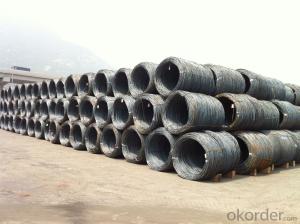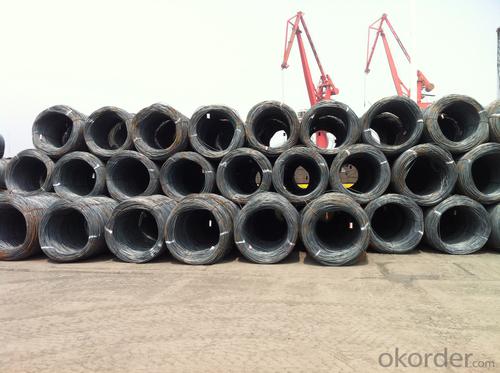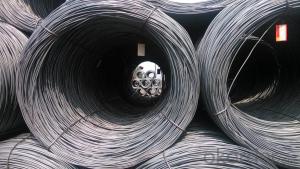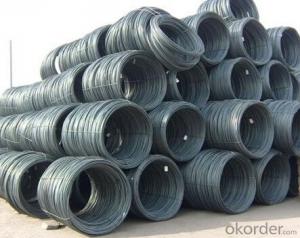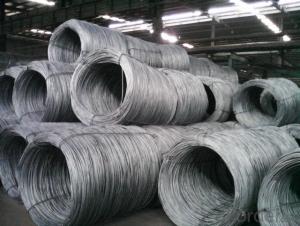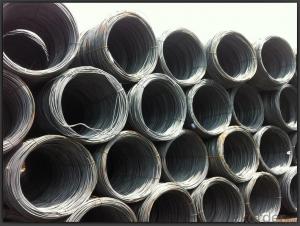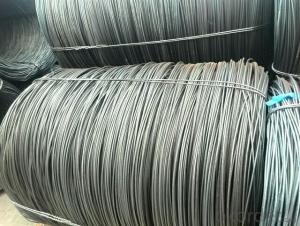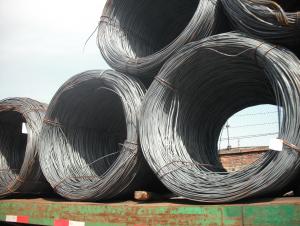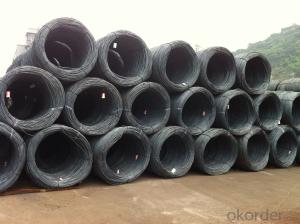Hot Rolled Wire rods with Grade SAE1008B and High Quality
- Loading Port:
- Tianjin
- Payment Terms:
- TT OR LC
- Min Order Qty:
- 25 m.t
- Supply Capability:
- 10000 m.t/month
OKorder Service Pledge
OKorder Financial Service
You Might Also Like
OKorder is offering Carbon Steel Wire Rod at great prices with worldwide shipping. Our supplier is a world-class manufacturer of steel, with our products utilized the world over. OKorder annually supplies products to European, North American and Asian markets. We provide quotations within 24 hours of receiving an inquiry and guarantee competitive prices.
Product Applications:
After hot-rolled the products shaped into coil . Since most of the products are round, it is generally called wire rod. Carbon steel wire rod is widely used in construction and manufacturing. Carbon steel wire rod is mainly used for reinforcement of reinforced concrete and welded structure or reprocessed (roberts , nail, etc.) materials, especially used to produce wire drawing, welding electrode, nails, spring, electronic, precise machinery parts and so on.
Product Advantages:
OKorder's Carbon Steel Wire Rod are durable, strong, and resist corrosion.
Main Product Features:
· Premium quality
· Prompt delivery & seaworthy packing (30 days after receiving deposit)
· Corrosion resistance
· Can be recycled and reused
· Mill test certification
· Professional Service
· Competitive pricing
Product Specifications:
Chemical Composition:
Please kindly find our chemistry of our material based on SAE1006/SAE1008 as below for your information
Grade | Chemical Composition (%) | |||||
C | Mn | S | P | Si | B | |
SAE1006 | 0.03~O.07 | 0.32max | 0.045max | 0.040max | 0.30max | 0.0008min |
Mechanical properties | ||||||
Yield strength(N/mm2) | Tensile strength(N/mm2) | Elongation (%) | ||||
250-280 | 350-380 | ≥32 | ||||
Grade | Chemical Composition (%) | |||||
C | Mn | S | P | Si | B | |
SAE1008 | 0.10max | 0.3~0.50 | 0.050max | 0.040 max | 0.15max | 0.0008 min |
Mechanical properties | ||||||
Yield strength(N/mm2) | Tensile strength(N/mm2) | Elongation (%) | ||||
≥195 | 315-430 | ≥30 | ||||
FAQ:
Q1: Why buy Materials & Equipment from OKorder.com?
A1: All products offered by OKorder.com are carefully selected from China's most reliable manufacturing enterprises. Through its ISO certifications, OKorder.com adheres to the highest standard and a commitment to supply chain safety and customer satisfaction.
Q2: How do you guarantee the quality of products?
A2: We have established an advanced quality management system which conducts strict quality tests at every step, from raw materials to the final product. At the same time, we provide extensive follow-up service assurances as required.
Q3: Can stainless steel rust?
A3: Stainless does not "rust" as you think of regular steel rusting with a red oxide on the surface that flakes off. If you see red rust it is probably due to some iron particles that have contaminated the surface of the stainless steel and it is these iron particles that are rusting. Look at the source of the rusting and see if you can remove it from the surface.
Q4:What's your payment terms ?
A4:Mostly,we collect the money by T/T and LC at sight . We also accept time LC at 90/120 days sight.
Image :
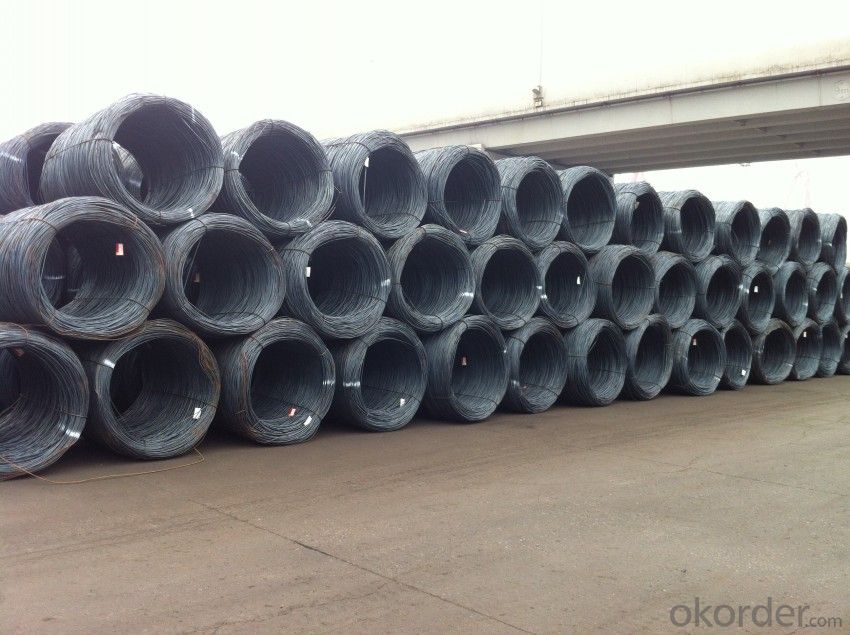
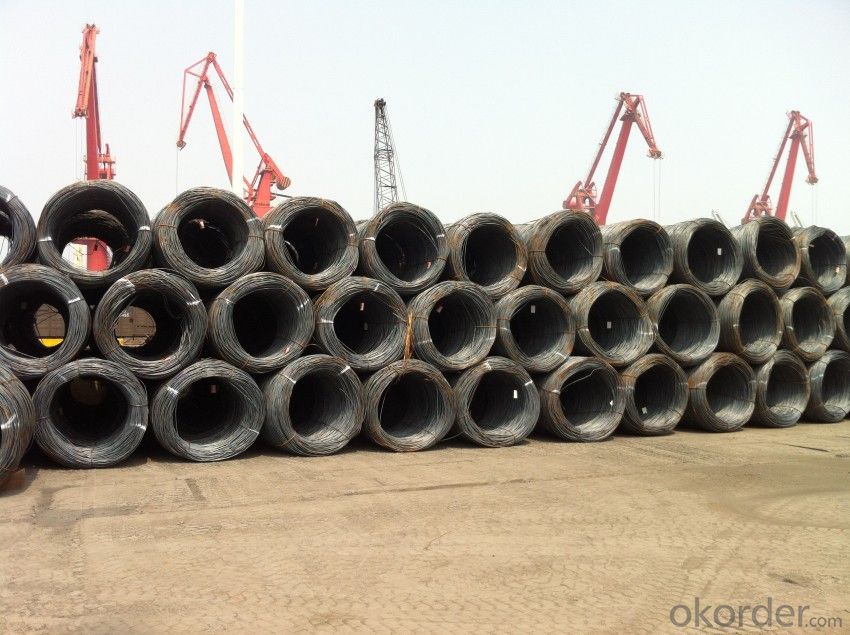
- Q: How is steel wire rod used in the manufacturing of wire for oil and gas pipelines?
- Steel wire rod is a crucial component in the manufacturing process of wire used for oil and gas pipelines. It serves as the primary raw material for wire production due to its strength, durability, and ability to withstand extreme conditions. The manufacturing process starts with the selection of high-quality steel wire rod, which typically consists of low carbon steel or alloy steel. This raw material is carefully chosen to meet specific requirements such as strength, corrosion resistance, and flexibility. The steel wire rod is then subjected to a series of manufacturing processes, including cleaning, descaling, and surface preparation. These steps ensure that any impurities or contaminants are removed, resulting in a clean and uniform surface. Next, the steel wire rod is heated to a specific temperature and passed through a series of dies to reduce its diameter. This process is known as drawing and is repeated several times until the desired wire diameter is achieved. The drawing process also imparts the wire with increased strength and improved mechanical properties. After drawing, the wire is annealed to relieve internal stresses and enhance its ductility. This step involves heating the wire to a specific temperature and then cooling it slowly, resulting in a more flexible and workable material. Once the wire is annealed, it undergoes another cleaning process to remove any residue or impurities that may have accumulated during manufacturing. The wire is then coated with a protective layer to enhance its corrosion resistance, typically through processes such as galvanization or polymer coating. Finally, the wire is spooled onto large reels, ready for further processing or direct use in the manufacturing of oil and gas pipelines. The wire is carefully inspected for quality, ensuring that it meets the required specifications and standards for use in these critical applications. In the manufacturing of oil and gas pipelines, the wire produced from steel wire rod plays a vital role. It is used in various applications such as reinforcement, binding, or as a structural component. The high strength and durability of the wire ensure that the pipelines can withstand the harsh operating conditions, including high pressure, extreme temperatures, and corrosive environments. Overall, steel wire rod serves as the foundation for the manufacturing of wire used in oil and gas pipelines. Its properties of strength, durability, and ability to withstand harsh conditions make it an essential material for ensuring the reliability and longevity of these critical infrastructure components.
- Q: What are the different types of steel wire rod drawing machines?
- There are several different types of steel wire rod drawing machines used in the manufacturing industry. Some of the most commonly used machines include: 1. Single Block Drawing Machine: This is the simplest type of wire rod drawing machine. It consists of a single block through which the wire rod is passed multiple times to reduce its diameter. This machine is ideal for drawing thin wires with high precision. 2. Double Block Drawing Machine: As the name suggests, this machine consists of two blocks through which the wire rod is passed. The wire rod is first passed through the first block to reduce its diameter, and then it is passed through the second block to further reduce the diameter. This machine is commonly used for drawing medium-sized wires. 3. Multi Block Drawing Machine: This type of machine consists of multiple blocks through which the wire rod is passed in a sequential manner. Each block reduces the diameter of the wire rod, resulting in a more precise and uniform wire. Multi block drawing machines are often used for drawing thicker wires. 4. Bull Block Drawing Machine: This machine is specifically designed for drawing large diameter wire rods. It uses a rotating bull block with grooves to reduce the diameter of the wire. The wire rod is pulled through the rotating block, which applies pressure and friction to the wire to reduce its diameter. 5. Continuous Drawing Machine: This is a highly automated machine that continuously draws the wire rod to reduce its diameter. The wire rod is fed into the machine, and it passes through a series of blocks or dies that progressively reduce its diameter. Continuous drawing machines are commonly used for mass production of wires. These are just a few examples of the different types of steel wire rod drawing machines available in the industry. The choice of machine depends on the specific requirements of the wire being produced, such as diameter, precision, and production volume.
- Q: What are the challenges faced by the steel wire rod manufacturers?
- Some of the challenges faced by steel wire rod manufacturers include fluctuating raw material prices, intense competition in the market, stringent environmental regulations, and the need for continuous technological advancements to improve product quality and efficiency. Additionally, the industry also faces challenges related to transportation logistics, maintaining a skilled workforce, and managing supply chain complexities.
- Q: How is steel wire rod cooled after the rolling process?
- After the rolling process, steel wire rod is cooled using various methods to achieve the desired properties and prevent distortion or damage. One common cooling method is air cooling, where the hot wire rods are exposed to ambient air to gradually reduce their temperature. This process allows for controlled cooling and uniform temperature distribution throughout the wire rod. Another method is water cooling, which involves spraying or immersing the wire rods in water. Water cooling is more rapid and efficient than air cooling, as water has better heat transfer properties. It helps to quickly cool down the wire rod, resulting in improved mechanical properties and surface quality. In some cases, wire rods may undergo accelerated cooling using specially designed cooling beds or water sprays. This method involves forcing cool air or water onto the wire rod surface to rapidly reduce its temperature. Accelerated cooling is particularly useful for achieving specific mechanical properties or enhancing the wire rod's microstructure. Additionally, some wire rods may undergo controlled cooling processes such as controlled cooling in a furnace or cooling in a quenching tank. These methods involve placing the wire rods in a controlled environment, such as a furnace with a controlled atmosphere or a quenching tank filled with a specific cooling medium. These controlled cooling processes allow for precise temperature and cooling rate control, resulting in desired material properties and microstructure. Overall, the cooling process after the rolling of steel wire rods greatly influences their final properties and quality. The choice of cooling method depends on factors such as the desired properties, production capacity, and available resources.
- Q: What are the different types of steel wire rod coatings used for increased hardness?
- There are several types of steel wire rod coatings used for increased hardness, including metallic coatings like zinc, aluminum, and nickel, as well as non-metallic coatings such as ceramic and polymer.
- Q: What are the common production processes for gold-coated steel wire rod?
- The common production processes for gold-coated steel wire rod include wire drawing, cleaning, coating, drying, and annealing.
- Q: What are the advantages of using steel wire rod compared to other materials?
- There are several advantages of using steel wire rod compared to other materials. Firstly, steel wire rod offers high strength and durability, making it suitable for various applications where a strong material is required. Secondly, steel wire rod has excellent flexibility, allowing it to be easily bent or shaped without breaking, which makes it ideal for applications that require flexibility, such as in construction or manufacturing. Additionally, steel wire rod has good corrosion resistance, ensuring its longevity and suitability for outdoor or corrosive environments. Lastly, steel wire rod is widely available and cost-effective, making it a cost-efficient choice for many industries.
- Q: What is the average price of steel wire rod?
- The average price of steel wire rod can vary depending on several factors including market demand, production costs, and global economic conditions. As of [current year], the average price of steel wire rod ranges from [price range] per metric ton. However, it is important to note that prices can fluctuate significantly over time, so it is always recommended to consult with industry experts or suppliers for the most up-to-date and accurate pricing information.
- Q: What are the common production processes for iridium-coated steel wire rod?
- The common production processes for iridium-coated steel wire rod typically involve several steps. First, the steel wire rod is cleaned and prepared by removing any impurities and contaminants. Then, it undergoes a surface treatment process to enhance its adhesion properties. After that, a thin layer of iridium is deposited onto the steel wire rod using techniques such as electroplating or physical vapor deposition. This coating process ensures a uniform and durable iridium layer on the surface of the wire rod. Finally, the coated wire rod is inspected for quality control purposes before it is ready for further applications or manufacturing processes.
- Q: How is steel wire rod used in the manufacturing of wire harness assemblies?
- Steel wire rod is used in the manufacturing of wire harness assemblies as it provides strength and durability to the overall structure. The wire rod is often used as the core material around which the various wires are wrapped and secured. This ensures the stability and integrity of the wire harness assembly, allowing it to handle high levels of electrical current and withstand mechanical stress. Additionally, steel wire rod is also used to create the connectors and terminals that are essential for connecting the wires within the harness, ensuring reliable electrical connections.
Send your message to us
Hot Rolled Wire rods with Grade SAE1008B and High Quality
- Loading Port:
- Tianjin
- Payment Terms:
- TT OR LC
- Min Order Qty:
- 25 m.t
- Supply Capability:
- 10000 m.t/month
OKorder Service Pledge
OKorder Financial Service
Similar products
Hot products
Hot Searches
Related keywords

